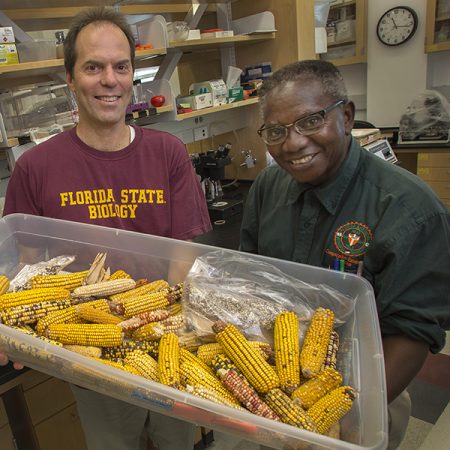
A long-standing partnership between Florida State University (FSU) and Florida Agricultural and Mechanical University (FAMU) researchers has led to a $2.1 million grant from the National Science Foundation’s Plant Genome Research Program that will allow them to better understand one of the country’s most important crops — corn.
FSU Associate Professor of Biological Science Hank Bass and FAMU Professor of Agronomy Oghenekome Onokpise, who have collaborated since the late 1990s, are working together along with a team of other investigators to map key functional regions of the genome of maize, more commonly referred to as corn.
“We essentially are setting out to develop a genomic chromatic structure of five tissues as a community service for the plant genetic research community,” said Bass, who is the lead investigator on the project.
Maize is considered the ideal plant to study because of its genetic diversity, so plant biologists around the world use it as the template to better understand how plants work. This is key information for farmers and the agriculture industry at large, according to the research team.
“It’s tremendously important,” Onokpise said. “Maize or corn is an important crop in the United States. The food versus fuel debate is on. By mapping various tissues, we can determine what is best for what — fuel, livestock feed, or fuel.”
But despite scientists studying plants for hundreds of years, there is still much to learn about their genetic underpinnings.
Using a chromatin mapping technique that Bass’ lab pioneered together with previous colleagues at FSU, Bass and Onokpise will examine five tissues or cell types in the corn. They are the root tips, shoot tips, pollen, ear shoots and endosperm. The endosperm is the part of the kernel that holds most of the nutritional value of the seed.
“Understanding the genomics of corn — a genetic model for most crops — means that our knowledge will be transferable,” Onokpise said.
To do the genetic mapping, Bass and Onokpise will use an enzyme called micrococcal nuclease to cut through the DNA. This tightly controlled experiment essentially lights up parts of the genetic material that functions to regulate gene expression and agronomic traits associated with the various tissues.
Outside of the main project to map the tissue, students at FSU and FAMU will be able to pursue individual projects related to corn’s genetic makeup, such as how the genes might be manipulated to make it survive environmental stresses such as droughts or flooding.
“This money allows us to do state-of-the-art research,” Bass said.
The grant will support two graduate students at FSU and one at FAMU, plus two undergraduate research projects per institution.
These students, along with Bass and Onokpise, will also engage the public by holding field projects to help interest high school students in STEM-related disciplines such as agriculture, genomics and bioinformatics.
In addition to Bass and Onokpise, several other researchers make up the team. They are FAMU Professor of Viticulture and Developmental Biology Violeta Tsolova, FSU Assistant Professor of Biological Science Jonathan Dennis, Associate Professor of Statistics Jinfeng Zhang and FSU Center for Genomics and Personalized Medicine Director Daniel Vera.




